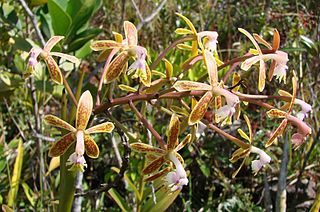
Orchids are plants that belong to the family Orchidaceae, a diverse and widespread group of flowering plants with blooms that are often colourful and fragrant.

Epidendrum radicans is a species of orchid. Common names include ground-rooting epidendrum, fire-star orchid, rainbow orchid, and reed-stem epidendrum. It is a common roadside weed at middle elevations in Central America. It is a crucifix orchid, often confused with many other members of the section Schistochila, including E. calanthe, E. cinnabarinum, E. denticulatum, E. erectum, E. fulgens, E. ibaguense, E. imatophyllum, E. incisum, E. schomburgkii, E. secundum, and E. xanthinum, among others. The diagnostic characteristic of E. radicans is its tendency to sprout roots all along the length of the stem; other crucifix orchids only produce roots near the base. Additionally, E. radicans flowers are resupinate, unlike the members of the Epidendrum secundum complex, E. fulgens, and many other crucifix orchids. E. radicans also differs from E. secundum by bearing no nectar in the flower.

Encyclia tampensis or Tampa butterfly orchid is a species of flowering plant in the orchid family, subfamily Epidendroideae.

Cattleya trianae, also known as Flor de Mayo or "Christmas orchid", is a plant of the family Orchidaceae. It grows as an epiphytic orchid, with succulent leaves, endemic to Colombia where it was nominated as the national flower in November 1936. That year, the National Academy of History of Argentina asked the Latin American countries to participate in an exhibition with the representative flowers of each country. The Colombian government gave the botanist Emilio Robledo the task to designate the most representative flowering plant of the country.

Epidendrum fulgens is a crucifix orchid native to Brazil. Like E. secundum, with which it has been found to hybridize in habitats disturbed by human activity, E. fulgens flowers are non-resupinate and are born in a congested raceme at the end of a long spike. Like all crucifix orchids, the lip is adnate to the column and bears three lobes, producing the effect of a cross. Like E. cinnabarinum, E. denticulatum, and E. puniceoluteum, E. fulgens grows in the litoral restinga habitat.

Epidendrum cinnabarinum, is a terrestrial reed-stemmed Epidendrum, discovered by the German collector Philipp Salzmann in Bahia, close to Salvador, and published by John Lindley in 1831. The specific epithet refers to the vermilion flowers. E. cinnabarinum is similar to E. fulgens and E. puniceoluteum, as well as red forms of the other crucifix orchids.

Epidendrum blepharistes is a species of orchid in the genus Epidendrum native to Bolivia, Colombia, Costa Rica, Ecuador, Peru, and Venezuela.

Epidendrum cristatumRuiz & Pav. (1789) is a species of orchid in the genus Epidendrum which is known to grow both terrestrially and epiphytically at altitudes near 1 km in the Neotropics from Mexico and Belize down through Brazil, as well as Trinidad.

Epidendrum ciliare, synonyms including Coilostylis ciliaris is a species of orchid. It is known as the fringed star orchid. It has a wide distribution from Mexico through Central America and the Caribbean to northern and western South America.

Epidendrum difforme is a species of orchid in the genus Epidendrum. In 1861, Müller classified this species in the subsection Umbellata of the section Planifolia of subgenus EuepidendrumLindl. of the genus Epidendrum.

Epidendrum conopseum, synonym Epidendrum magnoliae, sometimes called the green-fly orchid, is a species of orchid in the genus Epidendrum. It is the most northern-growing epiphytic orchid in North America, being found wild in the southeastern United States from Louisiana to North Carolina, and also in northeastern Mexico.

Epidendrum paniculatum is a species of orchid in the genus Epidendrum.

Brassavola nodosa is a small, tough species of orchid native to Mexico, Central America, the West Indies, and northern South America. It is also known as "lady of the night" orchid due to its citrus and gardenia-like fragrance which begins in the early evening. It has been widely hybridized and cultivated for its showy flowers and pleasing scent.

Cattleya walkeriana, or Walker's cattleya, is a species of orchid. It differs from most species of Cattleya by having inflorescences which arise from the rhizome instead of from the apex of the pseudobulb. In its native habitat it grows as either an epiphyte or a lithophyte, sometimes in full sun. Pseudobulbs are relatively short, bulbous or fusiform, with one or two ovate leaves at the apex. Inflorescence is one- or few-flowered, about 8" (20 cm) tall. Flowers are 4-5" (9-12 cm) across.

Encyclia oncidioides is a species of orchid. The diploid chromosome number of E. oncidioides has been determined as 2n = 40.
Epidendrum latilabre is a species of orchid of the genus Epidendrum which occurs naturally in French Guiana, Peru and Brazil. The diploid chromosome number of E. latilabre has been determined as 2n = 40.

Epidendrum rigidum is an epiphytic reed-stemmed Epidendrum orchid common throughout the Neotropical lowlands, below 600 m (2,000 ft).

Epidendrum calanthum is a terrestrial reed-stemmed Epidendrum orchid from the montane Tropical rainforest of Bolivia, Colombia, Ecuador, Peru, Venezuela, and the West Indies.
Epidendrum lanipes is an epiphytic sympodial orchid with spindle-shaped stems native to the montane tropical rainforest of Bolivia, Colombia, Ecuador, and Peru at altitudes ranging from 0.8 to 1.4 km.
Epidendrum cochlidium is a neotropical orchid which can grow both terrestrially and epiphytically in Peru and Venezuela at altitudes ranging from 1.2 km to 2.9 km.

















